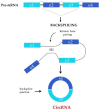Involvement of circRNAs in the Development of Heart Failure
- PMID: 36430607
- PMCID: PMC9697219
- DOI: 10.3390/ijms232214129
Involvement of circRNAs in the Development of Heart Failure
Abstract
In recent years, interest in non-coding RNAs as important physiological regulators has grown significantly. Their participation in the pathophysiology of cardiovascular diseases is extremely important. Circular RNA (circRNA) has been shown to be important in the development of heart failure. CircRNA is a closed circular structure of non-coding RNA fragments. They are formed in the nucleus, from where they are transported to the cytoplasm in a still unclear mechanism. They are mainly located in the cytoplasm or contained in exosomes. CircRNA expression varies according to the type of tissue. In the brain, almost 12% of genes produce circRNA, while in the heart it is only 9%. Recent studies indicate a key role of circRNA in cardiomyocyte hypertrophy, fibrosis, autophagy and apoptosis. CircRNAs act mainly by interacting with miRNAs through a "sponge effect" mechanism. The involvement of circRNA in the development of heart failure leads to the suggestion that they may be promising biomarkers and useful targets in the treatment of cardiovascular diseases. In this review, we will provide a brief introduction to circRNA and up-to-date understanding of their role in the mechanisms leading to the development of heart failure.
Keywords: cardiac fibrosis; cardiac hypertrophy; circRNA; heart failure; miRNA sponge.
Conflict of interest statement
The authors declare no conflict of interest.
Figures



References
Publication types
MeSH terms
Substances
LinkOut - more resources
Full Text Sources
Medical

